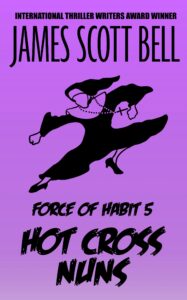by James Scott Bell
@jamesscottbell
 Happy Easter! And what better time for the reappearance of America’s favorite vigilante nun, Sister Justicia Marie of the Sisters of Perpetual Justice?
Happy Easter! And what better time for the reappearance of America’s favorite vigilante nun, Sister Justicia Marie of the Sisters of Perpetual Justice?
Yes, it’s finally here: FORCE OF HABIT 5: HOT CROSS NUNS. I had the title first. All I needed was the story to go with it. A hot cross … hmm … a stolen cross? But how big a deal would that be?
Then it hit me. Mrs. B and I love going to the Hollywood Bowl in the summer. We bring a picnic dinner and sit in an area that gives us a view of iconic Hollywood buildings, like Capitol Records, The Roosevelt Hotel (where, it said, the ghost of Marilyn Monroe hangs out), and the old, rugged Hollywood Cross. That was it! The perfect MacGuffin for the title.
A little L.A. history is in order:
[T] cross was conceived … as a memorial to one of Hollywood’s pioneers, Christine Wetherell Stevenson, the heiress to the Pittsburgh Paint fortune who helped arrange construction of the Hollywood Bowl. She was also an aspiring playwright who wrote “The Pilgrimage Play,” a pageant about the life and teachings of Jesus Christ.
In 1920, Stevenson chose 29 acres across the Cahuenga Pass from the Hollywood Bowl and helped carry stones from the nearby hills to build the open-air Pilgrimage Theater. She died two years later and in 1923, her admirers memorialized her by planting the cross on the hill above the theater.
Within six years, a brush fire destroyed the original theater and in 1931 Stevenson’s drama reopened in a concrete theater designed in what was described as an “ancient Judaic style.”
For many years, the cross was lighted only at Easter and during the annual “Pilgrimage Play” season. But the public’s affection for the landmark grew and soon Sunday school children were donating money to keep the cross lit.
Ultimately, Southern California Edison Co. assumed that expense and bore it until 1941, when the theater and cross were donated to the county. After the county supervisors accepted the gift, they renamed the theater after Supervisor John Anson Ford, recognizing his 24 years of service to the district in which the theater is located. The play continued its annual run until 1964, when the first in a series of lawsuits triggered by the facility’s religious uses forced an end to the performances.
The cross was damaged by fire a year later. The county replaced it with a steel and Plexiglas structure and operated it routinely for years. But the tradition came under legal fire in 1978, when a California Supreme Court ruling ended Los Angeles’ 30-year practice of lighting City Hall windows to form a cross at Christmas and Easter. Two years later, a college professor successfully argued in court that the county was violating the constitutional separation of church and state by maintaining the cross…
The cross, however, remained–dark and unguarded, abused and unused. Vandals chipped away at its foundation until a windstorm knocked it over it 1984.
Afterward, a small group of crusaders began raising funds for a new cross by doing a video documentary, recording a song, “The Ballad of the Hollywood Cross” by Mindas Masiulis, and collaborating with the Hollywood Heritage preservation group.
Almost 10 years later, with little fanfare, a new cross was erected on the small hilltop patch after the group purchased the site from the county.
So how could this landmark possibly be stolen? Who would do such a thing? And why? Find out in FORCE OF HABIT 5: HOT CROSS NUNS, on sale now for 99¢. Like the other novelettes in the series, it can be read as a stand-alone. The other entries are:
FORCE OF HABIT 2: AND THEN THERE WERE NUNS
FORCE OF HABIT 3: NUN THE WISER
FORCE OF HABIT 4: THE NUN ALSO RISES
I love seeing landmarks in fiction and film. Who will ever forget the chase over Mount Rushmore in North by Northwest? Or King Kong atop the Empire State Building? Or the Stay Puft Marshmallow Man stepping on Holy Trinity Lutheran Church in Ghostbusters, bringing forth Bill Murray’s classic line: “Nobody steps on a church in my town!”
The landmark doesn’t even have to be world famous. For example, there’s Top Notch Hamburgers in Austin, TX. That’s where Matthew “All right, all right, all right” McConaughey made his mark in Dazed and Confused.
So what’s a landmark in your home town? You do have one, you know. Even Takoma Park, Maryland has Roscoe the Rooster. So share yours!

